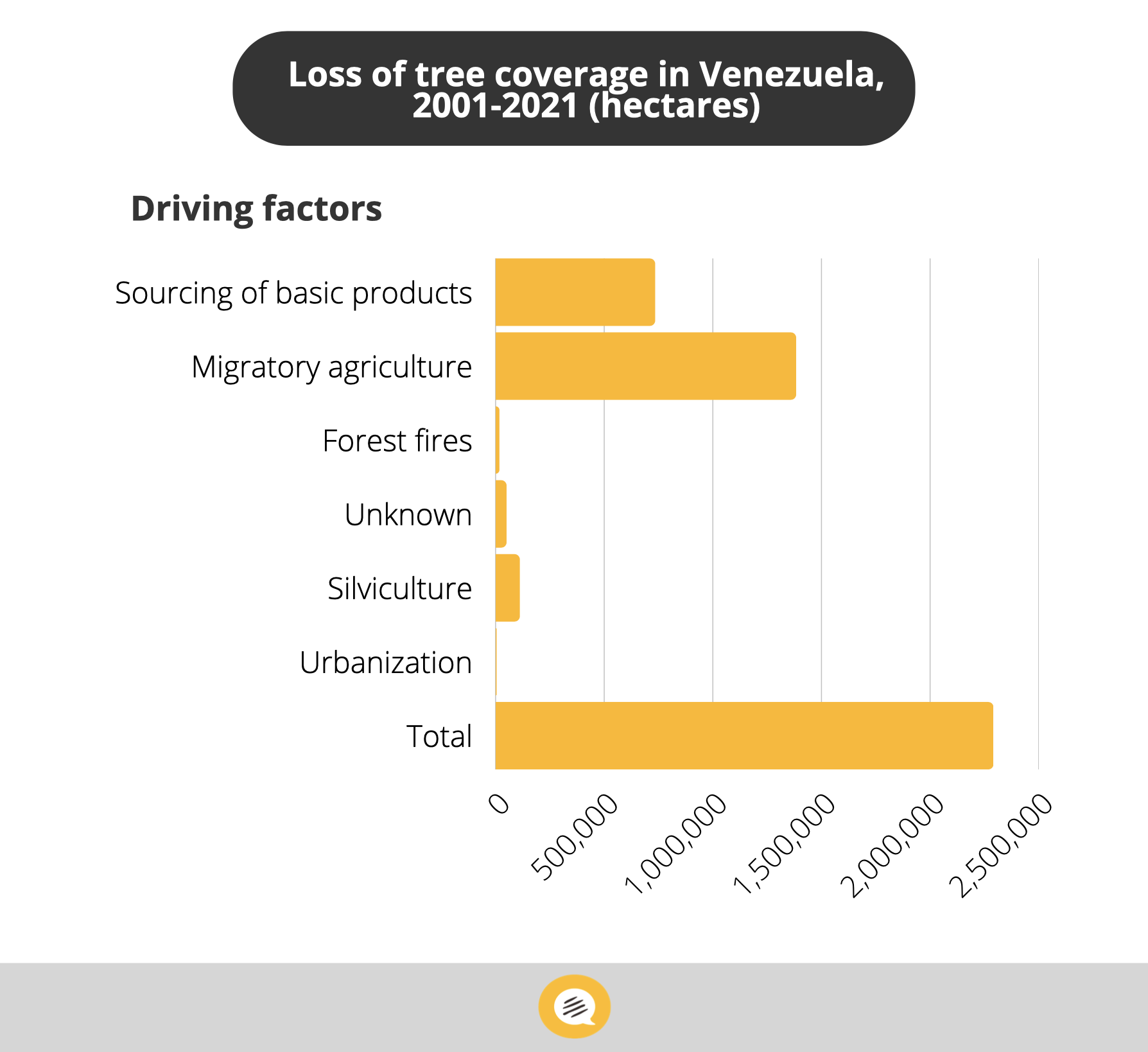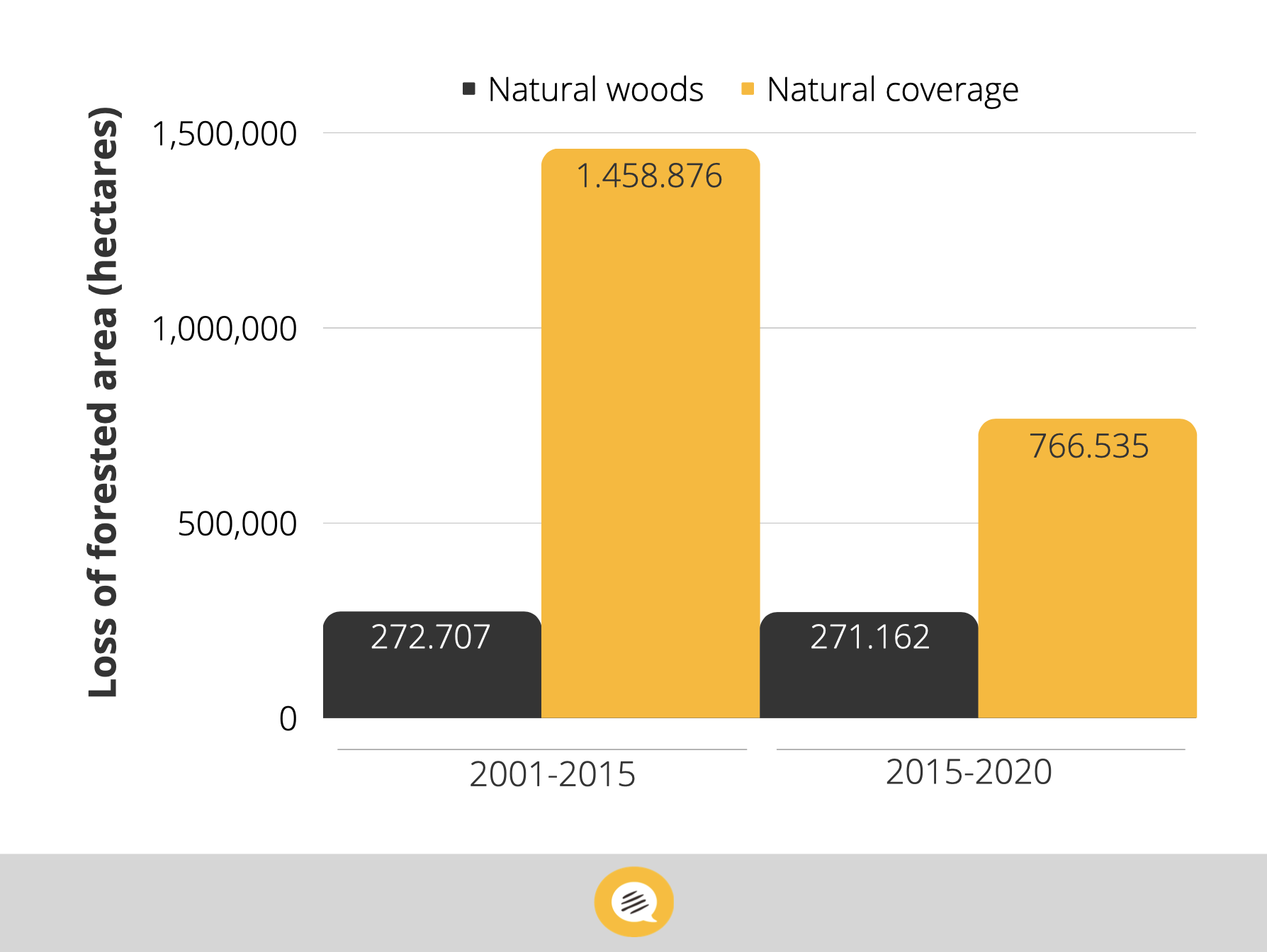Venezuela’s Deforestation Boom
Since 2016, when the Mining Arc came to be, the country has lost as much forest land as it had in the previous fifteen years: an area three times the size of the Greater Caracas. The causes: shifting cultivation, forest fires, and mining


Photo: Sofía Jaimes Barreto
During the 21st century, Venezuela hasn’t lost as much forest as the rest of the countries in the Amazon region, on average. But since 2016, trees have been cut down faster than in neighboring countries.
According to the report Bosques en desaparición: deforestación en Venezuela 2016-2021 by the environmental human rights NGO Clima21, between 2001 and 2021, Venezuela lost 4.1 percent of the forests it had until 2000. It’s a relatively low loss of forest coverage compared to the regional average of 9.9 percent. The same goes for the loss of old-growth or virgin forests, which has been 1.5 percent in Venezuela, while the regional average is 6.6 percent. But, in the last five years (2016-2021), Venezuela has shown the fastest-growing deforestation rate: 170 percent annually. In our country, trees are being cut down much faster than in Colombia and Bolivia, the next countries in growing deforestation speed.
Clima21 used information obtained from the digital tool Global Forest Watch (GFW), which generates data from remote sensors; from the Red Amazónica de Información Socioambiental Georreferenciada (Raisg)—a group of civil organizations from Amazonian countries—and the Map Biomas website, which generates yearly maps on coverage and ground usage. The study by Clima21 divided its analysis in two periods: before and after the creation of the Orinoco Mining Arc: 2001-2015 and 2016-2021.
According to the information by GFW, between 2001 and 2015 total forest coverage in Venezuela decreased by 97,258 hectares per year: twice the size of the Greater Caracas area. But during the 2016-2021 period, it decreased by 157,307 hectares per year: more than three times the surface area of Greater Caracas. In other words, in the last five years, we have lost the same amount of forest land as in the previous fifteen years. Since 2016, annual deforestation has increased by almost 60 percent than in the period before, which was three times as long.
Unbridled Extraction
Deforestation has fundamental effects on the human population. It contributes to almost a fifth of the greenhouse effect gas emissions which are causing climate change and it tends to increase zoonosis (viruses and animal diseases crossing over to humans) as malaria, Nipah and ebola epidemics show. According to research done by biologist María Eugenia Grillet, for instance, a decrease of 1.02 percent (over 3,000 hectares) of green coverage in San Isidro, Bolívar, goes hand in hand with a 746 percent increase in malaria cases.
Deforestation also affects the loss of access to water, ground erosion, and an increase in natural disasters: for example, the landslides of El Limón, which happened because the loss of green cover corrodes the highlands and allows rivers to change their course. Besides, it’s one of the main causes of the decrease of biodiversity. In the early 2000s, for instance, German biologist Winfried Meier pointed out that in the Cerro La Chapa—besides the extraction of wild birds he witnessed—coffee plantations had gone down to a number that threatened to wipe out the 14 endemic plants that grow in that forest. Ground erosion by cutting down trees in Morrocoy and the Coastal Range also increases the amount of sediments in the rivers, so when they reach the sea, it literally drowns large areas of coral reefs.
General coordinator of Clima21 Alejandro Álvarez Iragorry explains that, in the last few years, there have been three reasons that have boosted deforestation. First, “the State disengaged itself from environmental issues,” he says. “Their priority is the extraction of resources no matter what.” Secondly, the collapse in environmental institutions in the country have made the remaining bodies like the Ministry for Ecosocialism and Inparques “unable to perform their duties in situations where the country’s forests are being destroyed.” The third reason is the complex humanitarian emergency, which has pushed people to “extract natural resources in order to survive,” such as firewood and wildlife.
Deforestation on the Rise
The report says that deforestation had two major causes during the first period studied (2001-2015). First, shifting cultivation practiced by farmers without planning or financing. They burn forests to plant seeds and when the productive capabilities of these areas run out, they move to another place and repeat the process. This type of agriculture “can affect very broad lands without State planning controls,” Álvarez Iragorry says. Today, it’s the biggest threat in Caparo, the last forest of the eastern Llanos. The second reason for deforestation in that time frame was obtaining basic commodities: getting firewood to use for fuel, for example.
During the second period, 2016-2020, everything sped up. Shifting cultivation rose by 73 percent each year and obtaining basic commodities went up by 41 percent. Besides, the loss of forests to fires and other unknown causes also increased by 38 percent and 66 percent respectively. On the other hand, deforestation because of urban growth went down by 66 percent annually on average. They weren’t cutting down trees to expand cities, but to cook and eat.
The report warns that Venezuela was the Amazonian country with the highest density in forest fires in 2020, measured by the number of heat spots on the surface. While forest fires are growing throughout the Amazon, “in Venezuela, they could be tied to the complex humanitarian emergency,” Álvarez Iragorry says, “people looking for natural resources make fires to force animals to move or to ‘clean out’ areas of the forest in order to plant seeds.”
In the years of the most severe shortages, for example, hunting of flamingos and tortoises endemic to the south of the Maracaibo Lake were reported. Besides, the extended drought seasons could result in the forests being more susceptible to fires.
Deforestation in Venezuela is geographically uneven. Between 2001 and 2021, five states—Zulia, Monagas, Anzoátegui, Amazonas, and Bolívar—were the focus of almost 60 percent of the national deforestation. And between 2016 and 2021, some states increased their annual average deforestation rate by over one hundred percent: Sucre, Amazonas, Miranda, Carabobo, and Yaracuy. Meanwhile, the deforestation rate seems to have decreased in Guárico, Aragua, Táchira, Barinas, Mérida, and Portuguesa in the last six years.
Mining Wipes Out Natural Forests
Deforestation in Venezuela in recent years has been happening in old-growth forests: in other words, in the wooded natural ecosystems that haven’t been intervened before. In a consistent manner, old-growth forests represented 19 percent of all the woods lost between 2001 and 2015. That percentage rose to 35 percent during the 2016-2020 period.
“The rise in deforestation of old-growth forests probably has to do with the expansion of mining,” in the southern part of the country, Álvarez Iragorry says. For example, in the Cuyuní or Caura basins, which were considered the most pristine in Venezuela until the year 2000. Another hypothesis is that it’s the result of “the rise of agriculture because of an increase in the demand of food by mining communities in the area,” he explains.
According to the report, studies indicate that the main cause of deforestation in Bolívar is cattle farming and agriculture, while mining would be responsible for a small portion of it. However, recent work has stated that agriculture has decreased its expansion rate in Bolívar in the last decade. Besides, small and medium sized mining is the most frequent in the southern states and it can be underestimated in studies performed through remote sensors, like it has been observed in other Amazonian countries.
This is in contrast to the rise in deforestation in Colombia, where the peace process freed land for cattle farming and speculation on a large scale, and in Brazil, where Jair Bolsonaro’s policies have reduced forest protection. In Venezuela, deforestation is boosted by mining and small sustenance activities.
The Collapse of PDVSA Also Affects the Forests
According to Álvarez Iragorry, the high rates in Monagas, Anzoátegui, and Zulia could be the result of the loss of “job generating capabilities” because of the collapse of the oil industry. “Lots of people looked for resources in nature, with small farms, firewood extraction, hunting,” he says. These are states where people go back to the fields when they lose their jobs in the oil sector. Besides, deforestation in the Maracaibo Lake basin has accelerated to give way to agriculture, coal mining, and oil palm, which has isolated the jaguar populations in the south of the Lake.
The state of the oil economy could also be related to the deforestation rates. According to a comparative study in 2003 by Danish scientist Sven Wunder, deforestation in Venezuela accelerates during periods of crisis while the oil boom periods coincide with deforestation slowing down or reforestation. It’s no coincidence that the Mining Arc is chavismo’s answer to the collapse of the oil industry that had given them so much power before.
In fact, preliminary data for the year 2021 indicate a loss of forest land coverage of 64,424 hectares: an annual amount way below the average of previous periods (the same happens with deforestation in natural forests, comparable to the trend observed in 2016-2020). According to Álvarez Iragorry, the reasons for this recent reduction “aren’t very clear, at all.” On one hand, he says, “the fuel crisis, mobility difficulties, and criminal violence in mining areas can diminish the number of miners” who go to those areas. On the other hand, miners’ salaries were reduced at the beginning of the pandemic, although the international market increased. Also, “strategic alliances” of the government with private companies have resulted in the expulsion of many informal miners from areas like El Callao.
Going Towards a New Environmental Institutionalism
The report ends with a series of suggestions. For example, to gradually eliminate mining extraction as a means of funding the State. For Álvarez Iragorry, mining and oil have been a lot more harmful than beneficial for local communities. They also recommend structuring solid environmental institutions, which should have the capabilities, competency, and staff to face the causes of deforestation and generate economic sustenance in communities close to the forests, preventing them from being forced to cut down trees, and to establish an integral national policy for conservation and sustainable use of forest ecosystems and their resources as a basis for national development.
“The State has to consider environmental protection as a main pillar for national policies,” Álvarez Iragorry says. “Without effective national protection (of the environment), not only will the country not solve the current crisis, but it will possibly sink into more poverty.”
Caracas Chronicles is 100% reader-supported.
We’ve been able to hang on for 22 years in one of the craziest media landscapes in the world. We’ve seen different media outlets in Venezuela (and abroad) closing shop, something we’re looking to avoid at all costs. Your collaboration goes a long way in helping us weather the storm.
Donate






